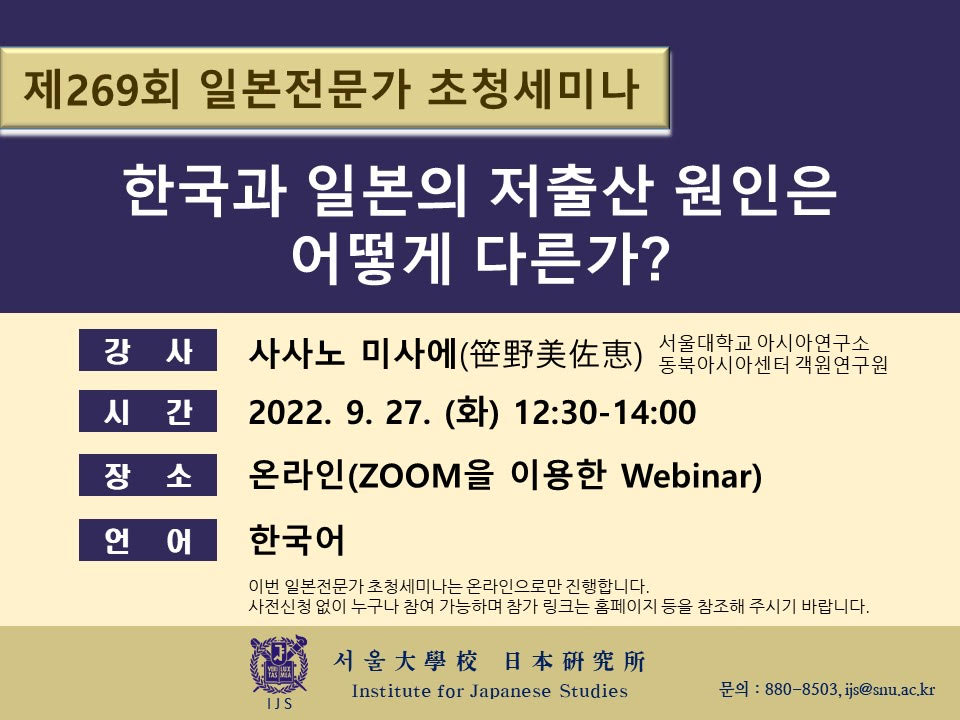
Institute for Japanese Studies has been hosting serieses of talks encompassing Japanese politics, economy, cultures and arts. With the experts from Europe, U.S. and Japan, we deliver the talks in multiple languages including Japanese, Korean and English.
We are pleased to host No.269 lecture as a part of Japan Specialist Seminars, titled “How the Causes of Low Birth Rate in Korea and Japan are Different "
*Please note the lecture will be hosted in Zoom only for the social-distancing rules.
Title : How the Causes of Low Birth Rate in Korea and Japan are Different
Lecturer : Sasano Misae (笹野美佐恵) , Visiting Research Fellow at East Asian Center, Seoul National University Asia Research Institute
Language : Korean
Time : 12:30 - 14:00, Sep 27th (Tuesday), 2022
Link : https://snu-ac-kr.zoom.us/j/5832898745
ZOOM ID : 583 289 8745
Summary :
In the developed countries of the late industrial society, the problem of low birth rates is common. However, In East Asian societies, including Japan and Korea, the fertility rate is far below the population replacement level. In Japan, the so-called 1.57 shock in 1989 raised public interest in falling fertility rates. Yet, even nowadays which is 30 years later since 1989, the fertility rate shows no signs of recovery. In Korea, the effort to shift such a trend was later than in Japan. Since the Ministry of Gender Equality and Welfare was launched in 2005, it has begun to come up with full-fledged measures. Until today, both governments have implemented various policies on the issue of low birth rates but the fertility rate has continued to decline, let alone the recovery.
Existing studies centered on the West have explained the low birth rate in Korea and Japan in the same context by finding commonalities in gender unequal division of roles (practical aspect), conservative and family-centered family values (value aspect), and family-oriented welfare policy (policy aspect). In reality, however, there are many differences as well as commonalities between the two countries. Why is Korea's fertility rate declining faster than that of Japan and has fallen to the lowest level in the world today?
In this lecture, I would compare the current status of low birth rates between Korea and Japan. Specifically, the time of emergence of the low birth rates as a topic, the difference in duration and speed of such a topic assumed through various statistical indicators and what measures have been taken by governments. In addition, I would like to understand the decline in the Korean fertility rate, which is falling faster than Japan. Despite the fact that the Korean government has spent much more budget than the Japanese government to devise various policies, such a phenomenon is occurring. Hence I will pay attention to the "change in family value" as a factor behind the scene.
Finally, the cause of the difference in the direction and speed of family value changes that are spreading among young women in both countries is found in the structural changes after the economic crisis in the 1990s. Specifically, it is explained in terms of differences in three aspects: 1. women's participation in the labor market 2. the higher education attainment of women 3. nature and direction of family/women's policies. As described above, through this lecture, I would like to examine the subtle and important differences in social, economic, and cultural backgrounds between Korea and Japan hidden in the common social phenomenon of "low birth" and discuss this problem together.